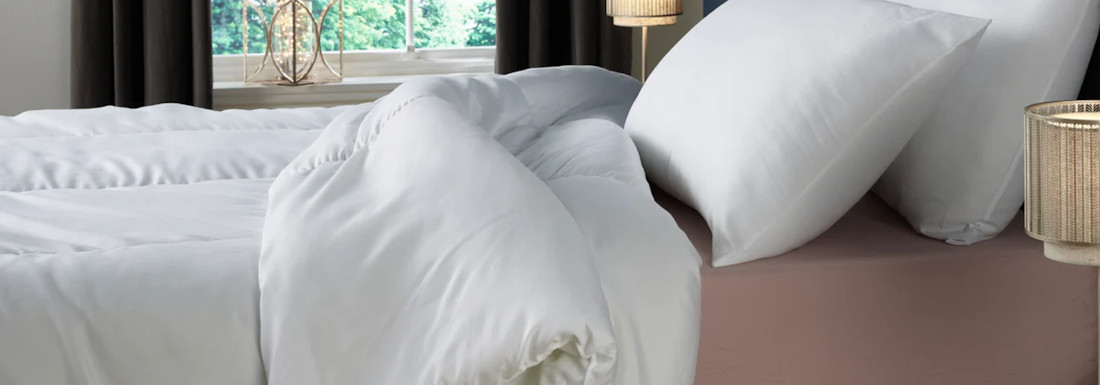

Anti-Allergy Waffle 4.5 Tog Duvet
Regular priceFrom £13.99
FREE delivery for UK mainland orders over £100
11 Sep 2025
When purchasing a duvet, your comfort and the quality of your sleep are at stake. It's an investment in your wellbeing, so avoid common duvet buying mistakes by being well-informed. Selecting the correct duvet goes beyond just matching it to your bed size; it involves understanding the various materials, fillings, and how they interact with your personal sleep preferences.
The myriad of options available can make duvet shopping seem daunting. It’s crucial to consider the duvet’s filling, as this affects both comfort and maintenance. Natural fillings like duck feathers or goose down offer warmth and fluffiness, while synthetic alternatives can be suitable for those with allergies. Don't overlook the importance of the duvet cover either, as it contributes to the overall sleep experience and ease of care.
Choosing the correct duvet material and filling contributes significantly to sleep quality by affecting warmth, weight, and sensitivity to allergies.
Your choice between natural and synthetic fillings depends on personal preference and specific needs. Natural fillings, typically made from duck down, goose down, or feathers, are known for their superior softness and insulation. They are exceptionally breathable and can provide a luxuriously lightweight, yet warm, sleep experience.
In contrast, synthetic fillings like microfibre and other down alternatives offer easy maintenance and affordability. They are often favoured for their hypoallergenic properties and suitability for those with allergies. Synthetic duvets can mimic the feel of down to an extent, but may not be as breathable or long-lasting as natural options.
| Natural Fillings | Synthetic Fillings |
|---|---|
| Goose down | Microfibre |
| Duck down | Hollowfibre |
| Feathers | Down alternative |
| Wool | Polyester fibres |
When evaluating down, wool, and feather varieties, consider their distinct characteristics. Goose down is often preferred for being lighter and warmer than duck down, which can be a bit heavier. The warmth of a down duvet is quantified by its fill power, with higher numbers indicating fluffier, higher-quality down.
Wool is another excellent natural filling, esteemed for its ability to regulate temperature, making it ideal for both hot and cold sleepers. Feathers are heavier and provide more structure than down, often resulting in a firmer duvet.
| Filling Type | Characteristics | Warmth |
|---|---|---|
| Goose down | Light and insulating | High |
| Duck down | Slightly heavier than goose down | Moderate to High |
| Feathers | Heavier and firmer | Moderate |
| Wool | Temperature regulating | Varies with blend |
For a good night's rest, especially for those with sensitivities, hypoallergenic and breathable options are key. Hypoallergenic duvets, often filled with synthetic fibres, reduce the risk of allergic reactions. Look for duvets treated to fend off dust mites and other allergens.
Breathable options are crucial for preventing overheating during the night. Natural fibres offer excellent breathability, but some synthetics are designed to wick away moisture and provide similar benefits. Selecting a duvet with these considerations in mind can enhance your comfort and the quality of your sleep.
| Hypoallergenic | Breathable | Maintenance |
|---|---|---|
| Synthetic | Natural fibres | Easy-care |
| Microfibre | Advanced synthetics | Frequent washing |
| Anti-allergy treatments | Cotton casings | Professional laundering for natural filings |
Remember, the best duvet for you is one that aligns with your personal needs considering warmth, weight, and health considerations.
Ensuring a good night's sleep depends on the duvet you choose. The ideal duvet offers the right balance of warmth, size, and quality, enhancing your comfort and the longevity of the product.
Tog rating measures a duvet's thermal insulation capability. For summer, a lighter duvet with a tog rating of around 4.5 is recommended, while in winter, a rating closer to 13.5 or higher would be more beneficial to withstand the cold. An all-season duvet is versatile, typically consisting of two separate duvets with different tog ratings that can be joined together or used separately to suit varying temperatures.
Selecting the correct duvet size ensures ample coverage for a comfortable sleep. However, opting for a slightly larger duvet can combat "duvet hogging" and add an aesthetic touch to your bed. The thread count, referring to the number of threads in a square inch of fabric, is another considerable factor. Generally, a higher thread count translates to a softer duvet cover and enhanced overall comfort.
Ideal thread count ranges:
Get the latest deals, bedding inspiration and updates from our team.
BLACK FRIDAY SALE NOW ON Click here to see the deals
